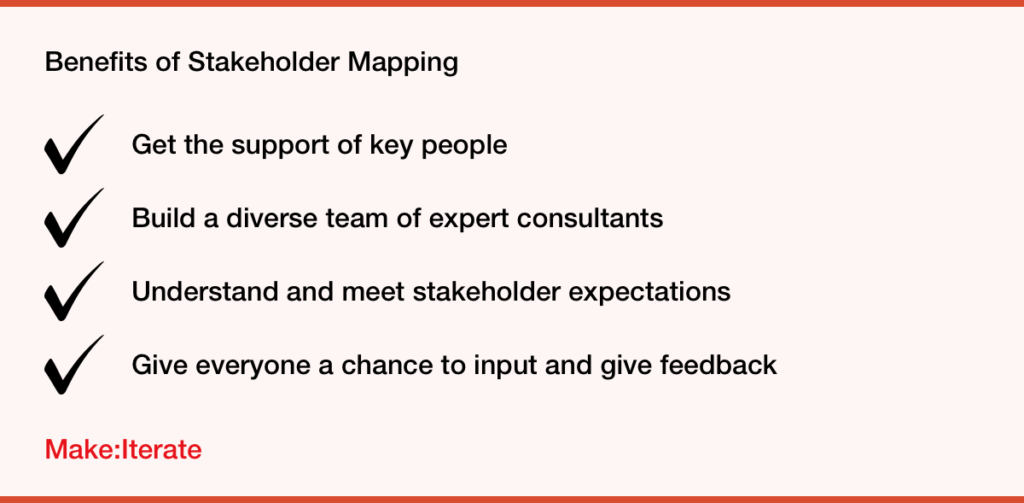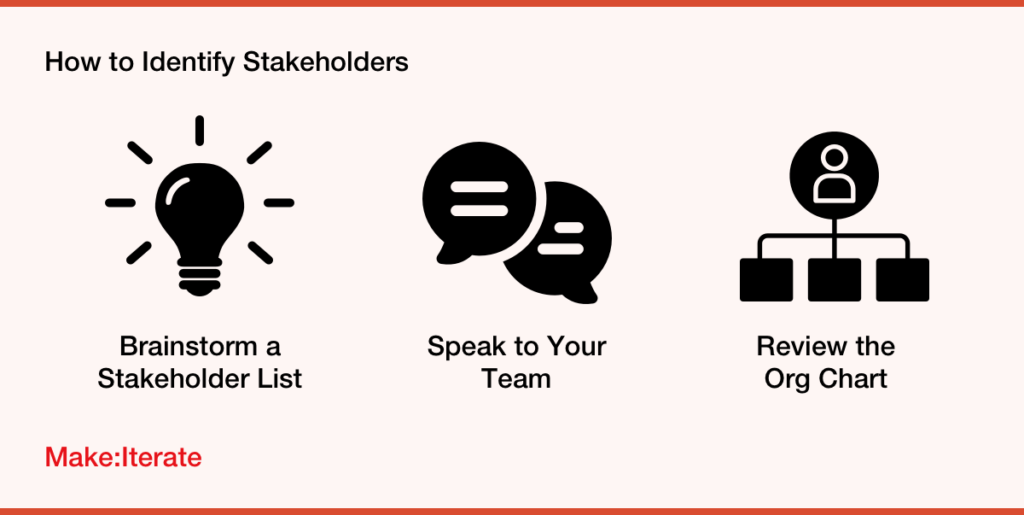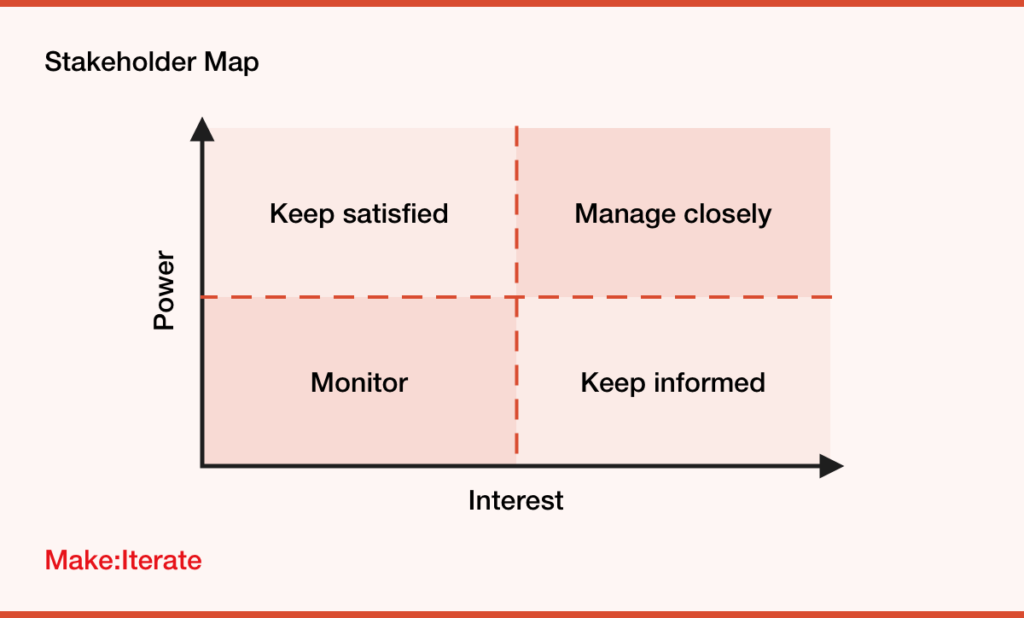In this article, you’ll learn how to identify stakeholders for a design thinking workshop, and how to involve them, so they can help to make your Design Thinking project a success.
Who Is a Stakeholder, and Why Do They Matter?
A stakeholder is anyone that might have an interest in your Design Thinking project.
It could be someone who might benefit from your work, someone working on a related project, or someone responsible for any of the decisions you’ll be making.
To ensure your project is successful, you need to understand who your stakeholders are and how to involve them throughout the project. You’ll need to know what they stand to gain from the project and their expectations.
A stakeholder is anyone with a vested interest in your project.
You’ll need to decide which stakeholder’s needs are more important, and how to balance them with the requirements of other stakeholders. Especially if there are any competing goals or agendas within the organization.
An example of competing needs could be that the marketing team wants to promote a new product with banners. In contrast, the UX team wants to remove distractions and increase task completion.
In a situation like this, you’ll need to figure out how to balance the needs of the different stakeholders and find a solution.

How Will Stakeholder Mapping Benefit Your Design Thinking Workshop?
Stakeholder mapping is a critical step in the Design Thinking process.
It helps you to plan your stakeholder engagement, understand stakeholder needs and decide who should be a part of the project team.
When you’ve completed your stakeholder analysis and your stakeholder map is ready. Start to think about who will participate in the design thinking activities and who can help your potential solutions succeed.
Stakeholder analysis is a process of understanding who your stakeholders are and what their needs are in order to make decisions about who should be involved in the project.
1. Build a strong team – Projects that do well often have a strong team built around them. People communicate often. They understand their roles and responsibilities and talk about the right things at the right times. With a group of diverse stakeholders, you can leverage their insight and different perspectives to deliver even greater innovative solutions.
2. Keep everyone happy – Stakeholders can react negatively if you don’t involve them. No matter how good your project is. You might also find that you ran the project at a bad time or the work had been prioritized for someone else to look at.
3. Get the support of key people – Give yourself the best chance of success by involving key people throughout the project. Get their ideas, absorb any information or learnings they have for you, and make them feel valued, so they’ll be willing to help you along the way. When you identify who is an important stakeholder, you can make sure you each have a shared understanding of what needs to be accomplished.
4. Meet stakeholder expectations – Some stakeholders might have a good idea of what they expect to happen as a result of the project. They may have success measures in mind or an idea about how your work should flow and connect to another project. Take the time to speak to them in advance so you can get on top of their ideas and figure out how to run your workshops to get the ideal outcome.
What Value Will Stakeholders Add to Your Project?
1. Share knowledge and expertise – Key stakeholders can help you by sharing helpful context about the business. For example, they can help you understand what’s been done in the past, the organization’s strategic goals, and what experience they’ve had with similar projects. This information could make or break your project.
2. Make things happen – Get things done to a high standard quickly with the support of influential people. These people could help you to keep pace and connect with the right people. Their support in public could also signal to the rest of the team that this is an important project and everyone should take it seriously.
3. Spot ways to improve – Spot risks and opportunities with the help of other experts around the business. More heads are better than one. Invite people to give feedback and critique your process to improve and find the best way to get things done.
4. Get the timing right – Timing is everything in a fast-paced organization. A good project done at a bad time will fail. If your project is a low priority for everyone because it’s the wrong time of year, you won’t get the support you need. Use stakeholders to help you decide when to start the project and how to align key activities with events happening in other teams.
In order to improve productivity in a fast-paced organization, it’s important to get the timing right for projects and gain traction by having the right people involved.
5. Help you to gain traction – The energy you get from your team will determine how successful your design workshop is. To get traction, you need the right people involved at the start, and you need to be able to direct their enthusiasm toward the right tasks.
6. Help you to keep momentum – Many design thinking projects fall flat because people lose interest after the first few workshops. Once you’ve been through the design process and have some ideas, you need people to help you keep the energy, make a new plan and follow through to make things happen.
7. Give you a budget and resources – You need people, tools, time, space, and maybe some money to get your workshop off to a good start. Key stakeholders should be able to help create the conditions for your project to be successful.
8. Help promote your project – Workshops are a great way to encourage collaborative thinking and inspire people around the organization to work in new ways. Some stakeholders can help you share the story of your project or give you the platform you need to present your process and findings to the organization.
The Different Types of Stakeholder
1. Key stakeholders are the people that will have the most influence over your project. They’re the people that are making decisions about whether or not your project goes ahead. They’ll likely influence the project’s direction and should be kept close throughout so they can give feedback and share their thoughts. Involve key stakeholders in the right way, and they can help you succeed and achieve your goals.
2. Primary stakeholders are the people who will be most interested in your work. They’re the people who will be impacted directly by the work you’re doing. These stakeholders will need to be kept close throughout the project since their involvement and support could help ensure your project is successful.
There are three types of key stakeholders: those who will have the most influence over your project, those who will be most interested in your work, and those who will be indirectly impacted by the project.
3. Secondary stakeholders are the people who will be indirectly impacted by the work you’re doing. Maybe they’re working on a related project or have similar goals to you. These stakeholders will need to be involved at key points throughout the project so they can hear about progress and any big decisions being made.
4. Tertiary stakeholders are the people that will be impacted the least. Maybe they’re a part of the same team but are working on an unrelated project, or perhaps they’re in the same organization and might have an interest but won’t have any involvement. It’s good to let these people know that the project is underway, and once it’s done, they might like to see a summary or a presentation of the outcomes.
Examples of who these stakeholders might be: An internal stakeholder could be a team member, other teams, your manager, brand, marketing, product team, tech team, data and analytics, research team, customer service, customers, or partners. An external stakeholder could be your customers, industry partners, or clients.

3 Steps on How to Identify Stakeholders
There are two main types of stakeholders within any project.
You have internal stakeholders – people from your organization who will be impacted by your project.
External stakeholders – These are people outside the organization, including customers, who will be affected by your work.
Within these groups, you can categorize stakeholders based on how much they’ll be impacted by your work and how much they want to be involved.
3 steps to creating a stakeholder list for your project are brainstorming with team, looking at org chart, and speaking to people.
Here are the different categories that you should consider when deciding who to include in your project:
1. Brainstorm a Stakeholder List
Spend time thinking and brainstorming about who might want to be involved in your project. Either because they’ll be directly impacted by it or because they might be interested in the outcome you produce.
2. Speak to Your Team
Do the brainstorming exercise with your team, your project manager, or your project sponsor. They’ll help you quickly identify who needs to be involved and ensure you aren’t missing anyone. You don’t have to nail it straight away; you can always build on it over time as you start to get the project underway.
3. Look at the Org Chart
Organization charts can be an excellent place to look if you need to find the names and roles of people around the organization. Some intranets or work systems could have this information. Sometimes, email applications have org charts attached to your contacts’ profiles.

How to Make a Stakeholder Map
What Is a Stakeholder Map?
A stakeholder map is a document that describes who is involved with your project and what roles they play.
A stakeholder map helps you identify stakeholders, prioritize their needs, and determine how to interact with them to ensure your workshop is successful. They’re used at the beginning of a project to identify who should be involved and when. And they’re used throughout a project to ensure you involve the right people at the right times.
1. Brainstorm Stakeholders
Spend some time on your own or with your team during a workshop to brainstorm ideas on who might need to be involved in your workshop and project overall.
Write your ideas on sticky notes and put them on a board or wall so you can see them all together.
2. Prioritize Stakeholders
Use the Power-Interest Matrix to organize your stakeholders.
This will give you a better picture of how each of them needs to be involved throughout your workshop.
Draw a grid like an example below. Then start to map your stickies to the different quadrants in the grid.
Each quadrant represents how much influence or interest a stakeholder could have over your project. Here’s a description of which stakeholders go into each quadrant.
Manage closely: These are the most important stakeholders. Put stakeholders in here if they have a lot of influence over the outcome of your project. They could be people that decide if your project goes ahead, assign a budget if you need it, or determine if you get the help you need to make your workshops successful. These people should be kept up to date throughout the project. They should be consulted as you progress and make critical decisions.
Keep satisfied: These people can have a lot of influence over your project but might not be as interested immediately as the ‘Manage closely’ group. They could be essential people within the business that need to be consulted and kept happy throughout. It’s best to get to know these people and ask them how they want to be kept up to date.
Keep informed: These people could be interested in what you’re up to, but they won’t necessarily influence or impact your project in any way. These people are likely to be team members working on different projects or people from somewhere else in the organization with similar goals. These people should be invited to key milestones where you share debriefs, progress and outcomes.
Monitor: These people probably aren’t interested in what you’re up to right now, but later on, they could come into play and take more interest. These people should be considered throughout and only be involved if their role has changed.
3. Get to Know Your Stakeholders
Now that you know who your stakeholders are and their role in the project, go out and speak to them to start to get an idea of their expectations.
Ask them how they’d like to be involved, how frequently they would like updates, and what outcomes they expect the project to achieve.
Take all of this information and use it to plan your workshops.
How to Involve Stakeholders Throughout Your Project
Keeping stakeholders happy can make or break a project.
It’s a lot of work to do it well, and honestly, it can distract you from other tasks you might enjoy more. Still, as the project lead, you must manage your stakeholders properly.
Here are some tips on how to involve stakeholders throughout a project:
Let them know their roles and what you expect of them. To get what you need from your stakeholders, they need to understand what their part is in the project, and they need to agree that they’re happy to perform that role. You should let them know what you need from them and when so they can put the time aside and prepare for their involvement.
Set expectations of how you’ll involve them and when. To get the attendance and attention you need from stakeholders. You need to make sure they can commit their time to the project. Tell them when you’ll need them, how long you’ll need them, and what preparation work might be needed.
In order to get what you need from stakeholders, let them know their roles and what you expect of them.
Share your schedule and get their commitment to key activities. Once you’ve made a plan and have an idea of when your workshops will take place. Share your plan with them, let them know the key milestones, and confirm that it works for them and their schedule. You might need to make tweaks if there are key people you need to be involved.
Invite them to help make important decisions. Whenever you’re making a big decision or recommendation or are moving into a new project phase. Invite key stakeholders to join you in making key decisions. If they feel it’s been a joint effort, you’ll get more buy-in and support.
Invite them to share their feedback, ideas, and suggestions. Invite stakeholders throughout the workshops to see what you’re up to and give them to share their feedback.
Conclusion
Give your workshops the best chance of success by involving the right people at the right time.
Use your team to help you identify stakeholders. Set expectations with them about their roles and responsibilities, and make an effort to involve them throughout and ensure their needs are met.
It can be a lot of work, but it’s important. Follow the steps in this article to get a good process in place so you can move through the process quickly and get all the help you need to run a world-class Design Thinking workshop.
Stakeholder maps are often used in UX design and the human centered design process to determine who your stakeholders are so you can assign them as a participant or key stakeholder that needs to be involved throughout the process.


